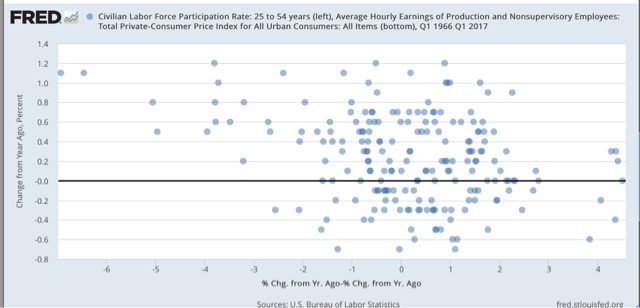By New Deal democrat Strong growth in labor force participation is correlated with weak realwage growth Prof. Jared Bernstein has a piece in the Washington Post today (and at his blog) noting that, even with much improved unemployment and underemployment rates, wage growth is still subpar. One item I wanted to add to the conversation is the inverse correlation between the prime age labor force participation rate and wage growth. As I I’ve pointed out several times in the last few months, most recently on Friday, more than 1% of the prime working age population has left the sidelines and entered the workforce since the beginning of 2016. This surge of participation has only been equalled twice in the last 30 years — in 1989 and 1995, as shown in the graph
Topics:
Dan Crawford considers the following as important: US/Global Economics
This could be interesting, too:
Joel Eissenberg writes How Tesla makes money
Angry Bear writes True pricing: effects on competition
Angry Bear writes The paradox of economic competition
Angry Bear writes USMAC Exempts Certain Items Coming out of Mexico and Canada
by New Deal democrat
Strong growth in labor force participation is correlated with weak realwage growth
Prof. Jared Bernstein has a piece in the Washington Post today (and at his blog) noting that, even with much improved unemployment and underemployment rates, wage growth is still subpar.
One item I wanted to add to the conversation is the inverse correlation between the prime age labor force participation rate and wage growth. As I I’ve pointed out several times in the last few months, most recently on Friday, more than 1% of the prime working age population has left the sidelines and entered the workforce since the beginning of 2016. This surge of participation has only been equalled twice in the last 30 years — in 1989 and 1995, as shown in the graph below:

In terms of supply and demand, this surge in participation means a big increase in the supply of potential workers. If the demand for labor has not changed materially, then we ought to expect lower wages to be paid to the new workers hired than would otherwise be the case.
So I created a scatterplot, shown below, of the YoY% change in prime wage labor force participation (left scale) vs. the YoY% change in real wages (bottom scale), averaged quarterly:
While in the middle part of the range, there does not appear to be any relationship, at the more extreme parts of the range, there clearly is. Big increases in real wages (the far right of the graph) only happen in situations where there is a decline in labor force participation, or at best a slight increase. Similarly, big decreases in real wages only happen when there is a big increase in labor force participation.
In short, while correlation does not necessarily mean causation, it certainly looks like the surge in labor force participation we have seen since the beginning of last year is part of the reason why nonsupervisory wages have grown so meagerly.

